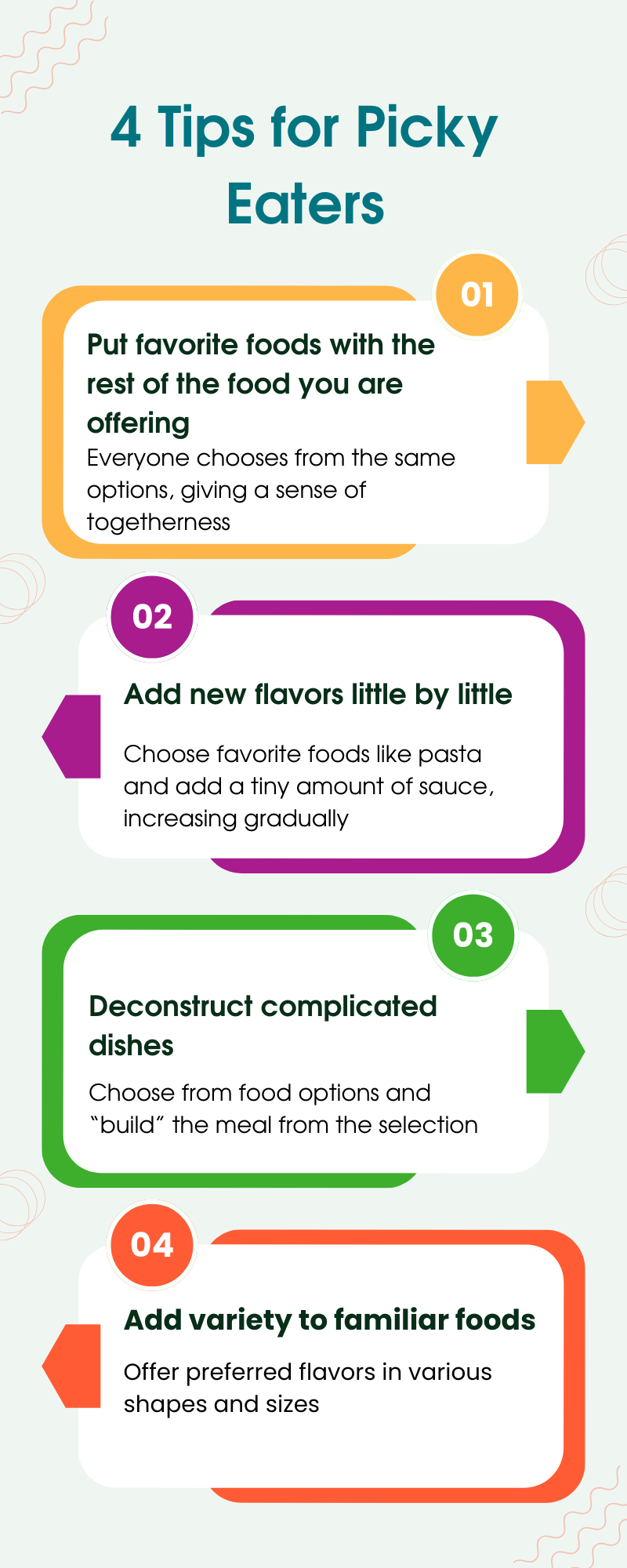Summary
Try four simple tips for picky eaters to help make mealtime more inclusive.
People have all kinds of reasons for food aversions or avoidance. Sensory (like experiencing strong or “weird” tastes, loud noises that crunchy foods make when chewed, uncomfortable pressure on teeth and jaws when chewing), motor (slippery or soft foods may hard for a person to control in their mouth without accidentally gagging) or negative memories like choking or being at a sad event when eating a food, all may affect one’s “food future”.
Some people may also have obsessive compulsive disorders that dictate how, when, and how much they eat, or hidden mental and emotional rules dictating things like if foods are “allowed” to touch each other, be eaten “out of order” or that one must avoid eating an odd number of things (like grapes) vs. an even number. Best wishes to the family chef – or to you yourself – if food variety is limited by disabling conditions. But fear not, here are some ways which may help anyone eat a wider variety of foods.
1. Put favorite foods with all the food you are offering
Picky eaters may gravitate to certain foods, and this can lead to making special dishes just for them. Try putting their favorite foods as part of a selection of a variety of foods. Putting everything in the middle of the table creates a sense of similarity rather than sending the message, “Your food is different from our food”.
Real family experience: Michael’s daughter, a picky eater, always stuck to her favorite chicken nuggets. By placing them alongside a variety of dishes, he noticed she became more open to trying new things, feeling like her choices were part of the family feast.

2. Add flavor little by little
Choose a preferred food and add a tiny bit of flavor in the mix. For example, a person who loves plain pasta with no sauce might enjoy having the option to dip the pasta, or simply add a very small, almost undetectable amount of sauce into the pasta to give it a subtle hint of flavor. If the hint of flavor is tolerated, gradually add more over time.
Real family experience: Eva, who preferred plain pasta, discovered a love for subtle flavors when her mom introduced a small amount of sauce. Gradually, she started experimenting with different sauces, turning mealtime into a flavorful adventure.

3. Deconstruct complicate dishes
Serving a dish that has multiple ingredients can look and taste overwhelming. Try offering ingredients that they can choose and assemble as they like. For example, taco night might feature tortillas alone with a separate bowl of each filling. People could eat each item separately, or combined as they choose.
Real family experience: The Smith family found that deconstructing lasagna into separate components allowed their son, with sensory sensitivities, to enjoy the meal. He happily assembled his plate with the ingredients he liked, turning a potentially overwhelming dish into a customizable delight.

4. Add variety to familiar foods
Try favorite flavors or textures in different foods, and note how they are similar. “These are raisins. They’re soft, sweet and chewy just like the gummy candies you like.” Or “You love Goldfish crackers. Here are cheesy square crackers that can go with them.” You also might try using a favorite dip as a way to try new food “dippers”. Begin with their favorite food and dip, say carrots and ranch dressing, then add a new food, like one piece of celery, to allow a little more exploration.
Real family experience: Mark’s son, a fan of Goldfish crackers, was introduced to new flavors by pairing them with different-shaped cheesy crackers. The explanation, “These are like the ones you love,” made trying new snacks feel like a natural extension of their preferences.


By experimenting with these family-friendly tips, you can turn the dinner table into a joyous experience for everyone. Remember to include favorite foods alongside a variety of options, creating a sense of togetherness rather than emphasizing differences. Gradually introduce flavors to cater to individual preferences and consider deconstructing complex dishes for a more manageable experience. Adding variety to familiar foods and using favorite dips as a gateway to new tastes can further enhance the positive, inclusive atmosphere at the table. Celebrating each unique palate is the key to creating lasting memories and fostering a sense of togetherness during mealtime.

